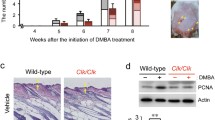Abstract
The induction of tumours by chemical carcinogens depends not only on the chemical structure of the substance but also on biological properties of the target cell population, such as enzyme patterns, DNA repair mechanisms and the proliferative state of the cells. Interference with any of these processes can theoretically affect the tumour yield, as can variations due to biological rhythms.
A series of investigations of circadian and circannual rhythms in the hairless mouse epidermis (hr/hr) is reviewed. DNA synthesis as well as the mitotic rate undergo great variations in the course of a 24-h period. The respiration and glycolysis in this epidermis undergo strong circannual variations. Evidence that the eventual tumour development after methylcholanthrene application to the skin is modified by circadian variations in DNA synthesis is presented and discussed in relation to pertinent data from other cell systems.
Zusammenfassung
Die Induktion von Tumoren mit chemischen Karzinogenen hängt nicht nur von der chemischen Struktur der Substanz ab, sondern auch von biologischen Eigenschaften der Zielzellpopulation, wie z. B. verschiedener Enzym-Muster, Repair-Mechanismen der DNS und der Proliferationsrate dieser Zellen. Jede Interferenz mit diesen Prozessen kann theoretisch die Tumorausbeute beeinflussen, wie auch Variationen durch biologische Rhythmen.
Es wird eine Übersicht über Untersuchungen der zirkadianen und zirkannualen Rhythmen an der Epidermis haarloser Mäuse (hr/hr) gegeben. Die DNS-Synthese wie auch die Mitoserate unterliegen großen Variationen im Verlauf einer 24-Std-Periode. Die Sauerstoffaufnahme und Glykolyse in dieser Epidermis weisen dagegen starke zirkannuale Variationen auf. Es gibt Anhaltspunkte dafür, daß die Tumorentwicklung nach einmaliger Methylcholanthren-Applikation auf die Haut von zirkadianen Variationen der DNS-Synthese modifiziert wird. Dies wird in Relation zu Daten anderer Zellsysteme diskutiert.
Similar content being viewed by others
References
Bertram, J. S., Person, A. R., Heidelberger, C.: Chemical oncogenesis in cultured mouse embryo cells in relation to the cell cycle. In Vitro 11, 97–106 (1975)
Brookes, P.: Covalent interaction of carcinogens with DNA. Life Sci. 16, 331–344 (1975)
Frei, J. V., Ritchie, A. C.: Diurnal variations in the susceptibility of mouse epidermis to carcinogen and its relationship to DNA synthesis. J. nat. Cancer Inst. 32, 1213–1220 (1964)
Frei, J. V., Harsono, T.: Increased susceptibility to low doses of a carcinogen of epidermal cells in stimulated DNA synthesis. Cancer Res. 27, 1482–1484 (1967)
Goth, R., Rajewsky, M. F.: Ethylation of nucleic acids by ethylnitrosourea-1-14C in the fetal and adult rat. Cancer Res. 32, 1501–1505 (1972)
Goth, R., Rajewsky, M. F.: Persistence of 06-ethylguanine in rat brain DNA: Correlation with nervous system-specific carcinogenesis by ethylnitrosourea. Proc. nat. Acad. Sci. (Wash.) 71, 639–643 (1974a)
Goth, R., Rajewsky, M. F.: Molecular and cellular mechanisms associated with pulse-carcinogenesis in the rat nervous system by ethylnitrosourea: Ethylation of nucleic acids and elimination rates of ethylated bases from the DNA of different tissues. Z. Krebsforsch. 82, 37–64 (1974)
Halberg, F.: Grundlagenforschung zur Ätiologie des Karzinoms. Mkurse ärztl. Fortbild. 14, 67–77 (1964)
Iversen, O. H., Iversen, U.: A study of epidermal tumourigenesis in the hairless mouse with single and with repeated applications of 3-methylcholanthrene at different dosages. Acta path. microbiol. scand. 62, 305–314 (1964)
Iversen, U., Iversen, O. H., Hennings, H., Bjerknes, R.: Diurnal variation in susceptibility of mouse skin to the tumorigenic action of methylcholanthrene. J. nat. Cancer Inst. 45, 269–276 (1970)
Laerum, O, D., Bjerknes, R.: Seasonal and individual metabolic variations of hairless mouse skin. J. invest. Derm. 58, 284–290 (1972)
Laerum, O, D.: Biologische Rhythmen der Haut. Kosmetologie 5, 2–8 (1974)
Lin, F. K., Banerjee, M. R., Crump, L. R.: Cell cycle-related carcinogen interaction during chemical carcinogen induction of nodule-like mammary lesions in organ culture. Cancer Res. 36, 1607–1614 (1976)
Magee, P. N.: Modern aspects of chemical carcinogenesis. FEBS Lett. 25, 210–216 (1972)
Marquardt, H., Bendich, A., Philips, F. S., Hoffmann, D.: Binding of (G-3H)-7,12-dimethylbenz(a)anthracene to DNA of normal and of rapidly dividing hepatic cells of rats. Chem.-biol. Interactions 3, 1–11 (1971)
Marquardt, H.: Cell cycle dependence of chemically induced malignant transformation in vitro. Cancer Res. 34, 1612–1615 (1974)
Miller, E. C., Miller, J. A.: Mechanisms of chemical carcinogenesis: Nature of proximate carcinogens and interactions with macromolecules. Pharmacol. Rev. 18, 805–838 (1966)
Mottram, J. C.: A diurnal variation in the production of tumours. J. Path. Bact. 57, 265–267 (1945)
Peterson, A. R., Bertram, J. S., Heidelberger, C.: Cell cycle dependency of DNA damage and repair in transformable mouse fibroblasts treated with N-methyl-N1-nitro-N-nitrosoguanidine. Cancer Res. 34, 1600–1607 (1974)
Rajewsky, M. F.: Proliferative parameters of mammalian cell systems and their role in tumor growth and carcinogenesis. Z. Krebsforsch. 78, 12–30 (1972)
Scheving, L. E., v. Mayersbach, H., Pauly, J. E.: An overview of chronopharmacology. Europ. J. Toxicol. 7, 203–227 (1974)
Süss, R., Maurer, H. R.: Reduced binding of carcinogenic hydrocarbons to DNA of mouse skin during inhibition of DNA synthesis. Nature (Lond.) 217, 752–753 (1968)
Tvermyr, E. M. F.: Circadian rhythms in epidermal mitotic activity. Virchows Arch. Abt. B Zellpath. 2, 318–325 (1969)
Tvermyr, E. M. F.: Circadian rhythms in hairless mouse epidermal DNA-synthesis as measured by double-labelling with H3-thymidine (H3Tdr.). Virchows Arch. Abt. B Zellpath. 11, 43–54 (1972)
Warwick, G. P.: Effect of the cell cycle on carcinogenesis. Fed. Proc. 30, 1760–1765 (1971)
Author information
Authors and Affiliations
Additional information
Read at the Symposium “Relevance of Chronobiology for Toxicology and Pharmacology” held at the 16th Spring Meeting of the Deutsche Pharmakologische Gesellschaft, Section: Toxicology, March 6, 1975, Mainz
Rights and permissions
About this article
Cite this article
Laerum, O.D. Possible influences of circadian rhythms in experimental carcinogenesis. Arch. Toxicol. 36, 247–254 (1976). https://doi.org/10.1007/BF00340532
Received:
Issue Date:
DOI: https://doi.org/10.1007/BF00340532




